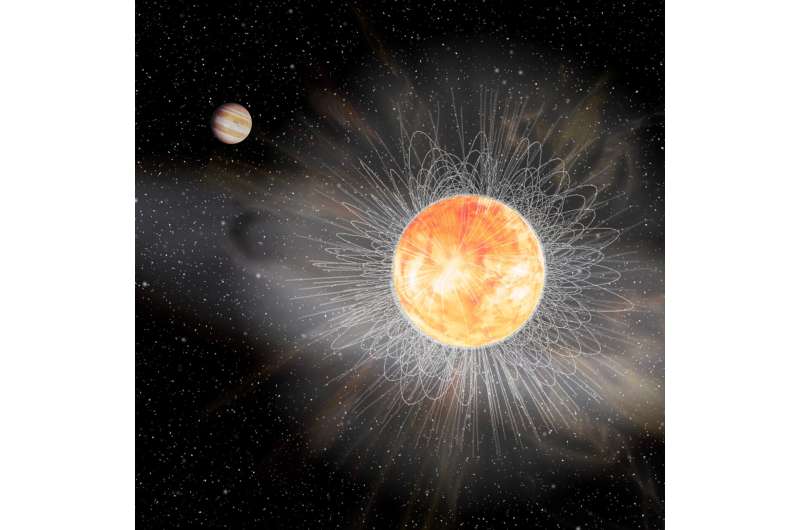This article has been reviewed according to Science X's editorial process and policies. Editors have highlighted the following attributes while ensuring the content's credibility:
fact-checked
peer-reviewed publication
trusted source
proofread
Old stars may be the best places to search for life

Once upon a cosmic time, scientists assumed that stars apply an eternal magnetic brake, causing an endless slowdown of their rotation. With new observations and sophisticated methods, they have now peeked into a star's magnetic secrets and found that they are not what they expected. The cosmic hotspots for finding alien neighbors might be around stars hitting their midlife crisis and beyond.
This groundbreaking study, shedding light on magnetic phenomena and habitable environments, has been published in The Astrophysical Journal Letters.
In 1995, Swiss astronomers Michael Mayor and Didier Queloz announced the first discovery of a planet outside our solar system, orbiting a distant sun-like star known as 51 Pegasi. Since then, more than 5,500 so-called exoplanets have been found orbiting other stars in our galaxy, and in 2019 the two scientists shared a Nobel Prize in Physics for their pioneering work. This week, an international team of astronomers published new observations of 51 Pegasi, suggesting that the current magnetic environment around the star may be particularly favorable for the development of complex life.
Stars like the sun are born spinning rapidly, which creates a strong magnetic field that can erupt violently, bombarding their planetary systems with charged particles and harmful radiation. Over billions of years, the rotation of the star gradually slows as its magnetic field drags through a wind flowing from its surface, a process known as magnetic braking. The slower rotation produces a weaker magnetic field, and both properties continue to decline together with each feeding off the other.
Until recently, astronomers had assumed that magnetic braking continues indefinitely, but new observations have started to challenge this assumption.
"We are rewriting the textbooks on how rotation and magnetism in older stars like the sun change beyond the middle of their lifetimes," says team leader Travis Metcalfe, a senior research scientist at White Dwarf Research Corporation in Golden, Colorado, U.S. "Our results have important consequences for stars with planetary systems, and their prospects for developing advanced civilizations."
Klaus Strassmeier, director at the Leibniz-Institute for Astrophysics in Potsdam, Germany and co-author of the study, adds, "This is because weakened magnetic braking also throttles the stellar wind and makes devastating eruptive events less likely."
The team of astronomers from the United States and Europe combined observations of 51 Pegasi from NASA's Transiting Exoplanet Survey Satellite (TESS) with cutting-edge measurements of its magnetic field from the Large Binocular Telescope (LBT) in Arizona using the Potsdam Echelle Polarimetric and Spectroscopic Instrument (PEPSI).

Although the exoplanet that orbits 51 Pegasi does not pass in front of its parent star as seen from Earth, the star itself shows subtle brightness variations in the TESS observations that can be used to measure the star's radius, mass, and age—a technique known as asteroseismology.
Meanwhile, the magnetic field of the star imprints a tiny amount of polarization on the starlight, allowing PEPSI on the LBT to create a magnetic map of the stellar surface as the star rotates—a technique known as Zeeman-Doppler Imaging. Together, these measurements allowed the team to evaluate the current magnetic environment around the star.
Previous observations from NASA's Kepler space telescope already suggested that magnetic braking might weaken substantially beyond the age of the sun, severing the close relationship between rotation and magnetism in older stars. However, the evidence for this change was indirect, relying on measurements of the rotation rate for stars with a wide range of ages. It was clear that rotation stopped slowing down somewhere near the age of the sun (4.5 billion years), and that weakened magnetic braking in older stars could reproduce this behavior.
However, only direct measurements of a star's magnetic field can establish the underlying causes, and the targets observed by Kepler were too faint for LBT observations. The TESS mission began collecting measurements in 2018—similar to Kepler's observations but for the nearest and brightest stars in the sky, including 51 Pegasi.
Over the past few years, the team began using PEPSI on the LBT to measure the magnetic fields for several TESS targets, gradually building a new understanding of how magnetism changes in stars like the sun as they grow older. The observations revealed that magnetic braking changes suddenly in stars that are slightly younger than the sun, becoming more than 10 times weaker at that point, and diminishing further as the stars continue to age.
The team attributed these changes to an unexpected shift in the strength and complexity of the magnetic field, and the influence of that shift on the stellar wind. The newly measured properties of 51 Pegasi show that—just like our own sun—it has already gone through this transition to weakened magnetic braking.
"It is very gratifying that the LBT and PEPSI were able to reveal a new perspective on this planetary system which played such a pivotal role in exoplanet astronomy," says Strassmeier, principal investigator of the PEPSI spectrograph. "This research is an important step forward in the search for life in our galaxy."
In our own solar system, life's transition from the oceans onto land occurred several hundred million years ago, coinciding with the time that magnetic braking began to weaken in the sun. Young stars bombard their planets with radiation and charged particles that are hostile to the development of complex life, but older stars appear to provide a more stable environment. According to Metcalfe, the team's findings suggest that the best places to look for life outside of our solar system might be around stars that are middle-aged and older.
More information: Travis S. Metcalfe et al, Weakened Magnetic Braking in the Exoplanet Host Star 51 Peg, The Astrophysical Journal Letters (2024). DOI: 10.3847/2041-8213/ad0a95
Journal information: Astrophysical Journal Letters
Provided by Leibniz Institute for Astrophysics Potsdam





















